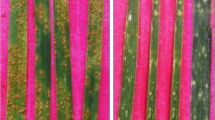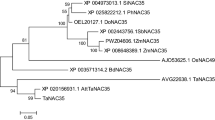Abstract
Early blight, caused principally by Alternaria solani, is one of the most important foliar diseases of potato. Candidate genes possibly involved in resistance were selected based on toxin resistance (Asc1 and metallothionein), pathogen recognition and response (ACRE-like, Pr5 and RBOH) and reduced cell death (BAX I). Gene expression levels of two resistant breeding line diploids, BD-1235 and BD-1265, along with a resistant wild potato, Solanum raphanifolium, were compared to two susceptible diploids, BD-1214 and BD-1217, at 18 h after inoculation with Alternaria solani. The largest change in gene expression occurred with the ACRE-like gene, a chitin responsive ubiquitin ligase, where all lines showed increases. The Asc1 gene was found to encode the toxin-resistant form in both susceptible and resistant lines. Expression levels increased in two resistant lines and one susceptible line but the gene was not expressed in S. raphanifolium. Both Pr5 and RBOH expression levels were low in all lines. Expression of two genes (metallothionein and BAX I) diverged, being downregulated in BD-1235 and upregulated in BD-1265 and S. raphanifolium, suggesting differences in resistance response between resistant lines. Functional gene analysis of transgenic Bintje potato plants with constitutive overexpression of metallothionein or BAX I revealed no significant change in disease observed in detached leaflets of metallothionein transgenics, while BAX I transgenics showed a reduction in lesion size and halo formation. Differences in resistance between the two sets of transgenic plants support the need to pair gene expression with functional analysis to properly determine resistance mechanisms.





Similar content being viewed by others
References
Abuley IK, Nielsen BJ, Labouriau R (2018) Resistance status of cultivated potatoes to early blight (Alternaria solani) in Denmark. Plant Pathol 67:315–326
Babaeizad V, Imani J, Kogel K-H, Eichmann R, Hückelhoven R (2009) Over-expression of the cell death regulator BAX inhibitor-1 in barley confers reduced or enhanced susceptibility to distinct fungal pathogens. Theor Appl Genet 118:455–463
Barna B, Gyorgyi B (1992) Resistance of young versus old tobacco leaves to necrotophs, fusaric acid, cell-wall degrading enzymes and autolysis of membrane lipids. Physiol Mol Plant Pathol 40:247–257
Bessadat N, Berruyer R, Hamon B, Bataille-Simoneau N, Benichou S, Kihal M, Henni DE, Simoneau P (2017) Alternaria species associated with early blight epidemics on tomato and other Solanaceae crops in northwestern Algeria. Eur J Plant Path 148:181–197
Brandwagt BF, Mesbah LA, Takken FLW, Laurent PL, Kneppers TJA, Hille J, Nijkamp HJJ (2000) A longevity assurance gene homolog of tomato mediates resistance to Alternaria alternata f. sp. lycopersici toxins and fumonisin B1. Proc Natl Acad Sci U S A 97:4961–4966
Brandwagt BF, Tarcies JA, Kneppers H, Nijkamp JJ, Hille J (2002) Overexpression of the tomato Asc-1 gene mediates high insensitivity to AAL toxins and fumonisin B1 in tomato hairy roots and confers resistance to Alternaria alternata f. sp. lycopersici in Nicotiana umbratica plants. Mol Plant Microb Interact 15:35–42
Danan S, Veyreiras J-B, Lefebvre V (2011) Construction of a potato consensus map and QTL meta-analysis offer new insights into the genetic architecture of late blight resistance and plant maturity traits. BMC Plant Biol 11:16
Evans IJ, Greenland A (1998) Trangenic approaches to disease protection: applications of antifungal proteins. Pestic Sci 54:353–359
Fry WE (2007) The canon of potato science: 10. Late blight and early blight. Potato Res 50:243–245
Gebhardt C, Ballvora A, Walkemeier B, Oberhagemann P, Schüler K (2004) Assessing genetic potential in germplasm collections of crop plants by marker-trait association: a case study for potatoes with variation of resistance to late blight and maturity type. Mol Breed 13:93–102
Gudmestad NC, Arabiat S, Miller JS, Pasche JS (2013) Prevalence and impact of SDHI fungicide resistance in Alternaria solani. Plant Dis 97:952–960
Guo J, Zhao X, Wang H, Yu T, Miao Y, Zheng X (2016) Expression of the LePR5 gene from cherry tomato fruit induced by Cryptococcus laurentii and the analysis of LePR5 protein antifungal activity. Postharvest Biol Technol 111:337–344
Harvey JJW, Lincoln JE, Gilchrist DG (2008) Programmed cell death suppression in transformed plant tissue by tomato cDNAs identified from an Agrobacterium rhizogenes-based functional screen. Mol Gen Genomics 279:509–521
Herriott AB, Haynes FL, Shoemaker PB (1986) The heritability of resistance to early blight in diploid potatoes (Solanum tuberosum, subsp. phureja and stenotomum). Am Potato J 63:229–232
Huckelhoven R, Dechert C, Kogel K-H (2003) Overexpression of barley BAX inhibitor 1 induces breakdown of mlo-mediated penetration resistance to Blumeria graminis. Proc Natl Acad Sci 100:5555–5560
Imani J, Baltruschat H, Stein E, Jia G, Vogelsberg J, Kogel K-H, Hückelhoven R (2006) Expression of barley BAX Inhibitor-1 in carrots confers resistance to Botrytis cinerea. Mol Plant Pathol 7:279–284
Jones RW, Perez FG (2014) Constitutive expression of a XEGIP in potato results in phenotypic changes suggesting endogenous inhibition of cell wall growth. Potato Res 57:133–144
Jones RW, Ospina-Giraldo MG, Clemente T (2004) Prosystemin-antimicrobial peptide fusion reduces tomato late blight lesion expansion. Mol Breeding 14:83–89
Kapsa JS (2008) Important threats in potato production and integrated pathogen/pest management. Potato Res 51:385–401
Kobayashi M, Yoshioka M, Asai S, Nomura H, Kuchimura K, Hitoshi Mori H, Doke N, Yoshioka H (2012) StCDPK5 confers resistance to late blight pathogen but increases susceptibility to early blight pathogen in potato via reactive oxygen species burst. New Phytol 196:223–237
Koiwa H, Kato H, Nakatsu T, Oda J, Yamada Y, Sato F (1999) Crystal structure of tobacco PR-5d protein at 1.8Å resolution reveals a conserved acidic cleft structure in antifungal thaumatin-like proteins. J Mol Biol 286:1137–1145
Landschoot S, Vandecasteele M, Carrette J, De Baets B, Hofte M, Audenaert K, Haesaert G (2017) Assessing the Belgian potato Alternaria population for sensitivity to fungicides with diverse modes of action. Eur J Plant Pathol 148:657–672
Lawrence CB, Singh NP, Qiu J, Gardner RG, Tuzun S (2000) Constitutive hydrolytic enzymes are associated with polygenic resistance of tomato to Alternaria solani and may function as an elicitor release mechanism. Physiol Mol Plant Pathol 57:211–220
Lehmanna S, Serranoa M, L’Haridona F, Tjamos SE, Metrauxa J-P (2015) Reactive oxygen species and plant resistance to fungal pathogens. Phytochem 112:54–62
Lynch D, Wastie R, Stewart H, Mackay G, Lyon G, Nachmias A (1991) Screening for resistance to early blight (Alternaria solani) in potato (Solanum tuberosum L.) using toxic metabolites produced by the fungus. Potato Res 34:297–304
Machado PP, Steiner F, Zuffo AM, Machado RA (2018) Could the supply of boron and zinc improve resistance to early blight? Potato Res 61:169–182
Magnin-Robert M, Le Bourse D, Markham J, Dorey S, Clément C, Baillieul F, Dhondt-Cordelier S (2015) Modifications of sphingolipid content affect tolerance to hemibiotrophic and necrotrophic pathogens by modulating plant defense responses in Arabidopsis. Plant Physiol 169:2255–2274
Maiero M, Bean GA, Ng T (1991) Toxin production by Alternaria solani and its related toxicity in tomato breeding lines. Phytopathol 81:1030–1033
Nagano M, Ishikawa T, Ogawa Y, Iwabuchi M, Nakasone A, Shimamoto K, Uchimiya H, Kawai-Yamada M (2014) Arabidopsis Bax inhibitor-1 promotes sphingolipid synthesis during cold stress by interacting with ceramide-modifying enzymes. Planta 240:77–89
Ni X, Tian Z, Liu J, Song B, Xie C (2010) Cloning and molecular characterization of the potato RING finger protein gene StRFP1 and its function in potato broad-spectrum resistance against Phytophthora infestans. J Plant Physiol 167:488–496
Oksana I, Hasan L, Imama T, Blindauer CA (2013) Diversity and distribution of plant metallothioneins: a review of structure, properties and functions. Metallomics 5:1146–1116
Ortiz R, Martin C, Iwanaga M, Torres H (1993) Inheritance of early blight resistance in diploid potatoes. Euphytica 71:15–19
Pelletier J, Fry W (1989) Characterization of resistance to early blight in three potato cultivars: incubation period, lesion expansion rate, and spore production. Phytopathol 79:511–517
Sánchez-Rangel D, Rivas-San Vicente M, de la Torre-Hernández ME, Nájera-Martínez M, Plasencia J (2015) Deciphering the link between salicylic acid signaling and sphingolipid metabolism. Front Plant Sci 6:125
Shah SFA, Mckenzie BA, Gaunt RE, Marshall JW, Frampton CM (2004) Empirical models of the relationships between early blight (Alternaria solani) and yield of potato (Solanum tuberosum) crop grown under different production environments. N Z Jour Crop Hort Sci 32:103–112
Shahbazi H, Aminian H, Sahebani N, Halterman DA (2011) Effect of Alternaria solani exudates on resistant and susceptible potato cultivars from two different pathogen isolates. Plant Pathol J 27:14–19
Torres MA, Dangl J (2005) Functions of the respiratory burst oxidase in biotic interactions, abiotic stress and development. Curr Opin Plant Biol 8:397–403
Tymon LS, Cummings TF, Johnson DA (2016) Pathogenicity and aggressiveness of three Alternaria spp. on potato foliage in the US northwest. Plant Dis 100:797–801
Visker MHPW, Heilersig HJB, Kodde LP, Van de Weg WE, Voorrips RE, Struik PC, Colon LT (2005) Genetic linkage of QTLs for late blight resistance and foliage maturity type in six related potato progenies. Euphytica 143:189–199
Wang H, Li J, Bostock RM, Gilchrist DG (1996) Apoptosis: a functional paradigm for programmed plant cell death induced by a host-selective phytotoxin and invoked during development. Plant Cell 8:375–391
Weber BN, Jansky SH (2012) Resistance to Alternaria solani in hybrids between a Solanum tuberosum haploid and S. raphanifolium. Phytopathol 102:214–221
Yellareddygari SKR, Taylor RJ, Pasche JS, Zhang A, Gudmestad NC (2018) Predicting potato tuber yield loss due to early blight severity in the Midwestern United States. Eur J Plant Pathol 152:71–79
Zhang Y, Yan H, Wei X, Zhang J, Wang H, Liu D (2017) Expression analysis and functional characterization of a pathogen-induced thaumatin-like gene in wheat conferring enhanced resistance to Puccinia triticina. J Plant Interact 12:332–339
Author information
Authors and Affiliations
Corresponding author
Additional information
Publisher’s Note
Springer Nature remains neutral with regard to jurisdictional claims in published maps and institutional affiliations.
Rights and permissions
About this article
Cite this article
Jones, R.W., Perez, F.G. Assessing Possible Mechanisms of Resistance to Early Blight Caused by Alternaria solani. Potato Res. 62, 423–434 (2019). https://doi.org/10.1007/s11540-019-9420-9
Received:
Accepted:
Published:
Issue Date:
DOI: https://doi.org/10.1007/s11540-019-9420-9




